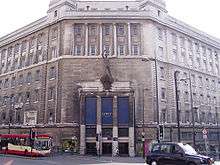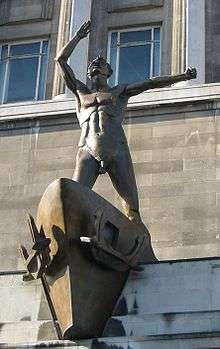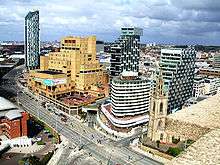Lewis's
Coordinates: 53°24′18.1″N 2°58′45.2″W / 53.405028°N 2.979222°W
 | |
| Department store | |
| Industry | Retail |
| Fate |
Lease unable to be renewed, brand name bought, grotto re-opened |
| Successor | Lewis's Home Retail |
| Founded | Liverpool, 1856 |
| Founder | David Lewis |
| Defunct | 29 May 2010 |
| Headquarters | Liverpool, England |
Key people |
David Thompson Sir Philip Green David Lewis Louis Cohen Rex Cohen Lord Woolton |
| Parent | Vergo Retail |
| Website | http://www.lewiss.co.uk |


Lewis's was a chain of British department stores that operated from 1856 to 2010. The parent companies of Lewis's have gone into administration many times over the years, including 1991. The first store, which opened in Liverpool city centre, became the flagship of the chain of stores operating under the Lewis's name. Several stores in the chain were bought in 1991 by the company Owen Owen and continued to operate under the Lewis's brand name for several years, but after the closure of the Manchester store in 2002, only the original Liverpool store continued to trade under the Lewis's name. This store was sold in 2007 to the Vergo Retail Ltd and closed in 2010.
History
The first Lewis's was opened in 1856 in Liverpool by entrepreneur David Lewis, as a mens and boys clothing store, mostly manufacturing his own stock. In 1864, Lewis's branched out into women's clothing. In the 1870s, the store expanded and added departments, including shoes in 1874, and tobacco in 1879. Also in 1879, Lewis's opened one of the world's first 'Christmas grottoes' in Lewis's Bon Marché, Church Street, Liverpool. It was named 'Christmas Fairyland'. His motto was Friends of the People, and he intended the shopping experience to be inclusive.[1]
The first Lewis's outside Liverpool opened in nearby Manchester in 1877, and another, by personal suggestion from Joseph Chamberlain on his new Corporation Street in Birmingham in 1885. The Manchester store included a full scale ballroom on the fifth floor, which was also used for exhibitions. Buying offices were also located on the fifth floor until a takeover by Liverpool-based competitor Owen Owen (see below). A fourth store opened in Sheffield in 1884 but proved unprofitable and closed in 1888.
Louis Cohen took over the business after Lewis's death, and oversaw a period of consolidation. After Louis Cohen's death, control passed to Harold and Rex Cohen, who took the company public in 1924. New stores were once again opened, in Glasgow (1929), Leeds (1932), Hanley in Stoke-on-Trent (1934) and Leicester (1936). Lewis's were generally among the largest department stores in their respective localities.
In 1951, the Lewis's group purchased the famous London department store Selfridges[2] and in 1965 became part of the Sears Group headed by Charles Clore. In 1966, the group launched Miss Selfridge Fashions, which would later become a store chain in its own right.
A branch was opened on Blackpool promenade, next to Blackpool Tower, in 1964 on the site of the Alhambra. The building had a distinctive 1960s design, with a turquoise tiled exterior. After it closed in 1993, building work was undertaken to remove some of the upper floors and the redeveloped site housed a Mecca bingo hall, with part of the ground floor space being subsequently occupied by Woolworths Group, now Poundland, Harry Ramsden's and a variety of smaller retail units.
The company's Manchester store was one of several targets attacked by the Provisional IRA on 27 January 1975.[3]
Christmas grotto
The world's first Christmas grotto opened in Lewis's in 1879, entitled 'Christmas Fairyland'. A staple of Liverpool's festive season, many generations first visited Father Christmas here, with the final displays covering over 10,000 square feet (930 m2). Since Christmas 2010, the Lewis's grotto manager, display team and staff moved the Lewis's Christmas Grotto to the 4th floor of Rapid Hardware, in the former George Henry Lee (John Lewis) building.
Decline
The company went into administration in 1991 as a result of a combination of problems, including the recession and failing to compete effectively. This resulted in Liverpool competitor Owen Owen buying up several branches of Lewis's (but retaining the Lewis's brand name on those purchased stores). Sir Philip Green revived the selling of toys on a large scale, by launching the brand Kids HQ in four Lewis's Owen Owen Stores, including those in Liverpool and Manchester. The Leicester branch traded independently for a short while, following a management buyout, as 'Lewis's of Leicester', before eventually closing. Other branches including the Birmingham store closed down.
After the 1996 Manchester bombing by the Provisional Irish Republican Army (PIRA) in Manchester, trading space in Lewis's was rented to Marks & Spencer and other smaller retailers displaced following heavy damage to the Corn Exchange. Both Marks & Spencer and the small retailers moved into new accommodation in 1999. The store suffered from a smaller footfall thereafter, and attempted to fight back by reinventing itself as partially a 'discount retailer'. In a final attempt to arrest the decline, the remainder-clothing retailer TK Maxx was invited to trade from the basement floor. In 2002, the Manchester branch ceased trading; it is now occupied by a branch of Primark.
The last store to trade as Lewis's was the Liverpool original. This followed the sale of other branches of Lewis's from Owen Owen to other operators such as Debenhams and Allders during the 1990s.
On 28 February 2007, the Liverpool store went into liquidation.[4] On 23 March 2007, it was sold as a going concern to Vergo Retail Ltd, enabling the store to continue to trade as Lewis's.[5] In February 2010, it was announced that the store would close permanently in June 2010 as the lease could not be renewed.[6] The final day of trading was 29 May 2010.[7] Until closure, the building retained its original lifts which had no controls for shoppers, being controlled by a lift operator who worked from a fold-down seating platform next to a lever.
Rebirth
After Vergo Retail went into administration, the rights to the Lewis's name were bought by Lewis's Home Retail Ltd. They intended to open a home store in Bury later that year, and have since bought out six branches of TJ Hughes. Including the Liverpool branch, which was ironically also the first branch of Owen Owen. They have also set up a website. However a planning application has been submitted to Bury Council confirming that the company do not wish to relaunch this classic brand and have decided to make this store a TJ Hughes instead.
Lewis's Home Retail purchased seven Paul Simon Homeware stores in 2014. The have chosen to relaunch these stores under the Lewis's brand. This coincides with the launch of TJ Hughes 'Lewis's' branded homeware goods. The items are tagged 'Established 1856' referencing the historic store. Lewis's Home Retail Limited also owns Lewis's related brand names including 'Kids HQ' and 'Owen Owen'.
Former branches
- Liverpool (1856–2010) — now part of the Central Village development, partially occupied by PureGym and Adagio Aparthotel
- Manchester (1877–2002) — now Primark
- Hanley, Stoke-on-Trent (1934–1998) — Debenhams since 1998
- Leeds (1932–1996) — became an Allders, now a Sainsburys
- Oxford (1957–1996) — subsequently Allders, and now Primark
- Blackpool (1964–1993) — became Mecca Bingo and Woolworths
- Bristol (1958–1981) — bought by John Lewis, since occupied by Bentalls, House of Fraser, now Primark
- Birmingham (1885–1991) — now offices, shops and restaurants
- London (Selfridges)
- Newcastle (1985–87) — replaced by Hamleys, then Mark One and HMV, now Forever21
- Glasgow (1929–1990s) — now Debenhams
- Leicester (1936–1993) — demolished
- Sheffield (1884–1888)
- Weston Favell (Supa-Centre) (1975–1985)
- Ellesmere Port (Supa-Centre)
- Planned to open store in Cheadle (ref. Tale of two Cities by K Evans, P Fraser & I Taylor)
Current branches
These are non-original stores owned and operated by Lewis's Home Retail Limited, and are former Paul Simon Stores rebranded under the Lewis's name.
- Chelmsford
- Colindale
- Harlow
- Lakeside
Sculpture

Above the main entrance to the Liverpool flagship store is a statue of a nude man by Sir Jacob Epstein. Its official title is Liverpool Resurgent but is nicknamed locally as either 'Nobby Lewis' or 'Dickie Lewis'. The statue was unveiled for Lewis's Centenary celebrations in 1956, which came as the blitzed store had completed rebuilding. It is a well-known local meeting place, and was immortalised in the 1962 anthemic song In My Liverpool Home by Peter McGovern:
- "We speak with an accent exceedingly rare,
- Meet under a statue exceedingly bare"
Lewis's Bank
From 1928, Lewis's included a banking department in each store. It was incorporated as a subsidiary limited company in 1934, and was owned by Martins Bank from 1958 to 1967 when it was bought by Lloyds Bank. It continued to operate into the 1980s.[8]
Lewis's Bank under Martins' ownership
Details of the nine year ownership 1958 - 1967 of Lewis's Bank by Martins Bank are published within Martins Bank Archive at www.martinsbank.co.uk . Lewis's retained its name and operated as a separate entity to Martins throughout. In addition to a general history, the Archive has separate pages which cover each of the ten branches of Lewis's in existence at that time, illustrated with stories and pictures from visits made to them by Martins Bank Magazine. Each Branch page also has a gallery of some of the staff who worked there. There is also a page to which former Lewis's Bank staff from this period can see and share memories. Martins Bank Archive maintains a Lewis's Bank staff database covering the nine years, and family tree researchers can enquire about New Entrants, Transferred and/or Promoted Staff, Marriages, Retirements and Deaths.
Popular culture
- The store gave rise to the well-known phrase "Standing there like one of Lewis's". As a popular meeting place for dating couples, 'standing like one of Lewis's' referred to being 'stood up'. It has also been described as being due to idle staff, the statues by Jacob Epstein (The Liverpool Resurgent) at the Liverpool branch, and The Man of Fire at the Hanley branch, or the reputation of the Lewis's Arcade at the Manchester store (as popularised in the 1960 film: Hell is a City)
The 1990 claymation of Terry Pratchett's Truckers has short interior scenes shot at the Manchester branch of Lewis's, as appears in the credits.
See also
- Sears Group (Sears plc) (unrelated to Sears of the USA)
- Bill Smith (fell runner)
- Blacklers (another Liverpudian Department Store)
- David Lewis Centre
References
- ↑ "Lewis' the shop that time forgot - Daily Telegraph p.17 Mar 2011". Retrieved 23 Dec 2014.
- ↑ "Lewis's". The Liverpool Wiki. Retrieved 20 July 2013.
- ↑ http://hansard.millbanksystems.com/commons/1975/jan/28/bomb-incidents
- ↑ "Lewis's bosses call in receivers". BBC News. 28 February 2007.
- ↑ "Jobs saved as iconic store sold". BBC News. 22 May 2007.
- ↑ "Lewis's legacy of 154 years trade". BBC News. 22 February 2010.
- ↑ John Siddle (29 May 2010). "Liverpool department store Lewis's closes its doors today". Liverpool Echo.
- ↑ "Lewis's Bank Limited - Lewis's Bank Archive". Martins Bank Archive. 18.5 Web Design. Retrieved 2 June 2016.
Further reading
- Briggs, Asa (1956). The Friends of the People: the centenary history of Lewis's.
- Lewis's Directory for the Towns of Manchester and Salford for the Year 1788. Manchester: Lewis's, [188-?] (Text of Edmond Holme's original directory republished with map of Old Manchester and Salford. pp. 47–65 contain "A description of Manchester" (written for this edition). pp. 66–72 contain "Lewis's": extract from a letter from Mr. Ike Halky to Mr. Hugh Bett, and the back wrapper advt. for Lewis's and view of the store (at 106-122 Market Street). The map reproduces one showing the two towns ca. 1794. British Library catalogue dates as [1880?] which is perhaps too early: Lewis's Manchester store was established in 1877, having been founded in Liverpool in 1856.)
External links
| Wikimedia Commons has media related to Lewis's. |
- New Lewis's Home Store Website
- Lewis's Famous Christmas Grotto at Rapid, Liverpool
- 5th Floor project
- (http://www.martinsbank.co.uk)


